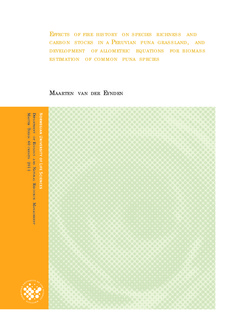| dc.description.abstract | High-elevation ecosystems have recently received increasing attention from the carbon financing sector. This has sparked the need for reliable and non-destructive methods to estimate carbon stocks in these ecosystems. The puna grasslands of the high Andes represent such a system and the current study investigated species richness and carbon stocks (in above- and below ground biomass) at a puna site in Peru. The study also examined the effect of fire on species richness and carbon stocks by comparing burnt and unburnt areas. Species-specific allometric equations were developed for four grass species, and generalised grassland equations were developed, combining data from both the burnt and unburnt area. No significant difference in carbon stocks between the burnt and unburnt area was found. The areas combined contained on average 3.4 Mg C ha-1 ± 0.1 SE stored in above-ground biomass, and 3.1 Mg C ha-1 ± 0.2 SE in below-ground biomass. Species richness was similar, but species composition differed somewhat between the burnt and unburnt area; the exotic species Juncus balticus was found mainly in the burnt area, and two Lycopodium species were found mainly in the unburnt area. However, Calamagrostis sp. was the dominant grass species in both areas. Highly significant allometric models were developed for four grass species separately. A generalised model combining the four was also developed. Some of the species-specific equations were affected by fire history. These results suggest that carbon estimations using allometric equations in puna grasslands can be more accurate if the fire history of the study area is known. It also seems that puna grasslands can recover their carbon stocks within three years of burning. However, species composition is altered by fire and appears to need more time to revert to pre-fire structure. | en_US |
